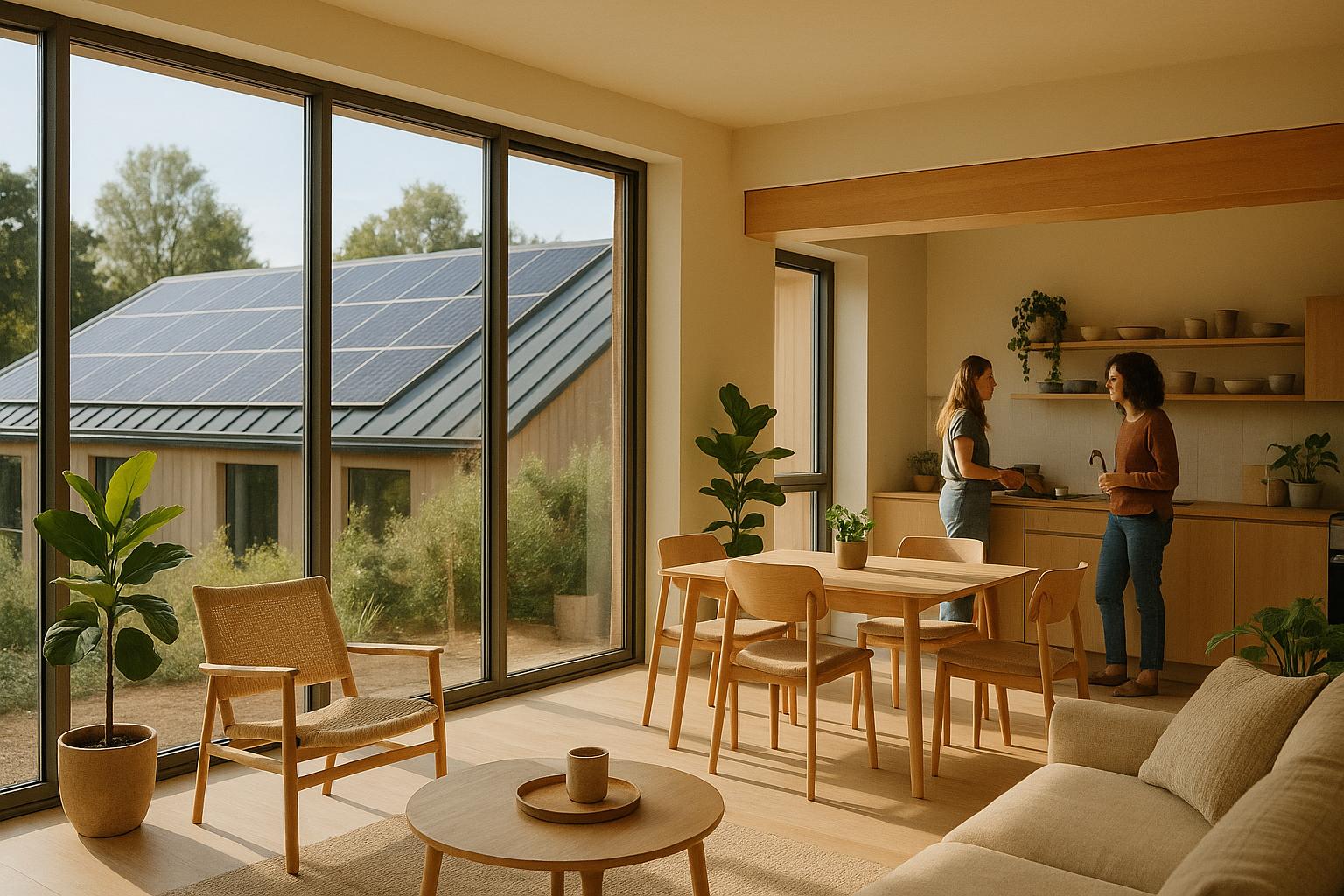Shared living is reshaping housing for Millennials and Gen Z. Rising rents, stagnant wages, and a desire for community are driving young adults toward co-living spaces. Here's why:
- Affordability: Shared living cuts housing costs by up to 40%, with all-inclusive pricing covering rent, utilities, and furniture.
- Flexibility: Month-to-month leases make it easy to adapt to job changes or relocations.
- Community: Built-in social networks and events help combat loneliness in urban areas.
- Convenience: Fully furnished spaces and included services simplify moving and living.
With platforms like Coliving.com offering options in 380+ cities, shared living is becoming a practical and appealing solution for young adults navigating modern housing challenges.
Financial Pressures Behind the Housing Shift
Housing affordability in the U.S. is becoming a growing concern. With rents climbing and wages lagging behind, shared living has become a practical choice for many Millennials and Gen Zers. These younger generations are dealing with financial hurdles that older generations didn’t face to the same extent. As a result, shared living isn’t just an appealing option - it’s often a financial lifeline.
Rising Rent Costs vs. Income Levels
The gap between rising rents and stagnant income growth has reached troubling levels. Between 2019 and 2023, rents soared by 30.4% nationwide, while wages only grew by 20.2%. This disparity means housing costs now take up an even larger chunk of young adults' paychecks.
The numbers paint a stark picture. As of March 2025, the median rent in the U.S. hit $1,987, a 0.8% increase from the previous year. Meanwhile, the dream of homeownership feels increasingly out of reach. The median home price is now 5.6 times higher than the median salary. To put that into perspective, the average home price in Q1 2025 was $503,800, nearly double its inflation-adjusted price from 1981.
"We had a deal in this country … You get a job. You get a house by your 20s. That deal is broken." - Pierre Poilievre
With housing costs spiraling, many young adults are turning to shared living as a way to stretch their budgets.
How Shared Living Cuts Housing Costs
Shared living has become a smart financial strategy for those looking to reduce expenses. By splitting costs among multiple residents, shared living can significantly lower the financial burden of housing.
For example, renting a co-living space typically costs 15% to 20% less than renting a studio apartment in the same area. Additionally, shared living reduces utility costs, which average $429.33 per month. By dividing these bills, residents can make living expenses far more manageable.
The savings add up quickly. Living in a shared space can save someone around $500 a month, or $6,000 a year. For young adults juggling student loans or entry-level salaries, these savings can make a big difference.
Shared living also eliminates some upfront costs. Residents don’t need to buy furniture or appliances, as many co-living spaces come fully furnished. This removes another financial hurdle for those trying to live independently.
The trend is especially popular in pricey urban areas, where career opportunities draw young professionals despite sky-high housing costs.
"The emergence of co-living communities over the last few years has largely been a response to rising housing costs and the need for more affordable housing options - especially in major U.S. markets, which are attracting young professionals from other parts of the country." - CBRE and Streetsense
Experts agree that affordability is the key reason behind this shift in housing preferences:
"The driver is still cost. It's hard to find affordable units in many of these markets." - Jeanette Rice, Americas head of multifamily research for CBRE
For Millennials and Gen Z, shared living offers a way to balance financial stability with the desire to live in vibrant, opportunity-rich areas. It’s a solution born out of necessity, but one that allows them to maintain their lifestyle and location preferences.
Social Connection and Community Building
For Millennials and Gen Z, shared living isn’t just about saving money - it’s about finding a built-in community that helps combat the isolation often felt in urban environments.
Fighting Loneliness in City Living
Even in a world where 82% of Gen Z and Millennials rely on social media to stay connected, the pandemic highlighted how digital interaction can’t fully replace in-person connections. In fact, 33% of young Canadians reported feeling less socially engaged after moving during this period.
Shared living spaces tackle this issue head-on. After a long day at work, residents return to vibrant communal areas - think kitchens, lounges, and coworking spaces - designed to encourage organic interactions. Whether it’s cooking together, sharing coffee, or unwinding with a movie, these relaxed settings help digital natives, who sometimes struggle with face-to-face interaction, build meaningful, offline relationships.
"We bring people together after work because they don't need to go back to an empty apartment." - Matthias Zeitler, Founder of Coworking Bansko and Coliving Semkovo
These casual moments can lead to deep, genuine connections that grow naturally from shared routines. Beyond these everyday interactions, structured events further strengthen the sense of community.
Creating Real Communities
Shared living spaces go beyond just offering roommates - they actively cultivate a sense of belonging through planned activities and shared experiences. It’s no wonder that 85% of co-living residents say the camaraderie and sense of community are key benefits.
Community managers play a big role here, organizing events like movie nights, potlucks, and group fitness sessions to bring people together. One London-based co-living space even found that 68% of its residents felt their social lives improved because of such events.
These environments aren’t just about casual friendships - they often provide emotional support that rivals what families offer. Research shows that values-based communities can be even more effective than families at easing loneliness for Millennials and Gen Z. In fact, 94% of participants said these communities uplifted them with entertainment, inspiration, and joy.
Professional connections also thrive in these spaces. With many residents working in similar fields or sharing entrepreneurial goals, collaboration and networking happen naturally. For younger generations who prioritize experiences over possessions, this community-driven lifestyle aligns perfectly with their outlook. Three out of four Millennials and Gen Zers rank "quality of life" and "mental well-being" as top priorities when deciding where to live and work.
"Co-living is not just about splitting the rent – it's about community." - Forbes
This sense of belonging provides emotional stability, especially for those frequently relocating for work or adjusting to life after college. Younger Millennials and Gen Z are almost four times more likely than older generations to feel connected to people who share similar experiences or identities. For them, shared living isn’t just a housing option - it’s a way to feel grounded in an ever-changing world.
Flexible Living Options and Convenience
The days of rigid 12-month leases and juggling separate utility bills are quickly fading for Millennials and Gen Z. These generations are driving demand for more adaptable housing options that align with their fast-paced, ever-changing lifestyles.
Flexible Lease Terms and Life Changes
Traditional apartment leases, with their year-long commitments, often don’t work for young professionals navigating today’s unpredictable job market. Shared living spaces, on the other hand, provide the flexibility to adapt to career shifts and life changes. With rent prices expected to climb by about 3.5% by the end of 2025, according to Apartments.com, having the option to move without being tied to a long-term lease is more valuable than ever.
Many coliving spaces cater to this need by offering month-to-month options or short-term stays. For example, Mangrove, a coliving chain in South Korea, provides 3-month contracts, giving residents the freedom to explore new locations without the financial burden of long-term commitments.
"Choose the convenience and flexibility of monthly stays – our short leases make it easy to relocate quickly if your job demands it." - Coliving.com
As remote work becomes more common, freelancers, consultants, and remote employees can relocate with ease, avoiding the hassle of breaking leases or losing security deposits. This kind of flexibility is a game-changer for those who need to stay mobile in a rapidly evolving work environment.
All-Inclusive Housing Packages
Renting a traditional apartment often comes with a long list of responsibilities - paying separate bills, managing repairs, and furnishing the space. Coliving simplifies all of this by bundling nearly everything into one monthly payment.
Most coliving spaces come fully furnished, with utilities, internet, and even housekeeping services included. That means you can move in with just a suitcase - no waiting for internet installation, no shopping for furniture, and no dealing with utility deposits.
Maintenance is another headache you can skip. In a coliving setup, the management team takes care of repairs and upkeep. Whether it’s a Wi-Fi issue or a broken appliance, a quick message to the management team is all it takes to get things fixed.
Beyond the basics, many coliving spaces come with added perks like coworking areas, gyms, game rooms, and regular community events. These extras, which could cost hundreds of dollars in a traditional apartment, are included in the monthly rate. For Millennials and Gen Z, this all-in-one approach not only simplifies life but also helps save money - freeing up funds for experiences, travel, or tackling student loans.
How Coliving.com Makes Finding Housing Easy
Gone are the days of endless research, multiple site visits, and complicated rental applications. Coliving.com has streamlined the process of finding, booking, and managing shared living spaces entirely online.
The platform connects users to flexible, all-inclusive coliving spaces in over 380 cities across 70+ countries, with options starting as low as $100 per month. Whether you’re heading to Berlin, Bangkok, or Boston, Coliving.com makes it easy for digital nomads and remote workers to find housing that fits their needs.
With a network of 38,000+ rooms across 1,900+ coliving spaces, there’s something for everyone. Remote workers can filter for spaces with coworking areas and high-speed internet, while students can prioritize locations near universities with study-friendly environments. The search tools make it simple to find a space that matches your lifestyle.
The booking process is just as convenient, featuring online rental agreements, a money-back guarantee, and easy cancellation policies. For a generation accustomed to booking rides, meals, and vacations with a few taps on their phones, Coliving.com’s seamless online experience feels right at home.
"Co-living spaces, which are popular among millennials and Generation Z, cater to a demographic looking for community-oriented living without the commitment of traditional homeownership. Affordability, convenience, and social connectivity define these innovative housing solutions." - A Brilliant Tribe
How Shared Living Matches Generational Values
Millennials and Gen Z are turning to shared living not just for financial relief but because it aligns with their values - sustainability, diversity, and wellness. These generations, shaped by different priorities than those before them, find that shared living supports the way they want to live. Beyond saving money, this lifestyle reflects their broader ideals.
Environmental Benefits and Resource Sharing
For Millennials and Gen Z, caring for the planet isn't just trendy - it's essential. 73% of Gen Z consumers actively work to reduce household waste, and 89% of Gen Z and 86% of millennials acknowledge the reality of climate change. Shared living naturally complements these values by encouraging resource sharing, which reduces energy use and waste.
Instead of each resident owning separate appliances like washing machines or heating systems, shared spaces consolidate these resources. This not only lowers energy consumption but also minimizes environmental impact. Many coliving spaces go a step further by incorporating eco-friendly features such as solar panels, composting bins, and energy-efficient appliances. These setups make sustainable habits easier to adopt, fostering a community-wide commitment to mindful consumption.
The pandemic has further amplified the focus on sustainability. As Greg Petro writes in Forbes:
"The pandemic didn't start the sustainability revolution, but it has put it into hyperdrive, and Gen Z is in the driver's seat."
Shared living spaces often take the guesswork out of sustainability by offering recycling stations and composting areas, making it simple for residents to live more responsibly.
Diverse and Welcoming Living Spaces
For Millennials and Gen Z, diversity and inclusion are more than buzzwords - they’re priorities. 81% of Gen Zers say diversity influences their brand choices, and 75% of Gen Z consider a company's diversity efforts when applying for jobs. Shared living reflects these values by bringing together people from different backgrounds, cultures, and professions.
Unlike traditional apartment complexes, where neighbors often remain strangers, coliving spaces are designed to encourage interaction and connection. This intentional setup fosters a sense of community that celebrates differences. In fact, 72% of mainstream consumers report that some of their closest relationships are with people who don’t share their race, ethnicity, or sexual identity.
By tailoring spaces to various tastes and cultural preferences, shared living creates environments where personal growth and understanding thrive. Dr. Marcus Collins from the University of Michigan explains:
"These groups have been disproportionately influential. And today, cultural circles are more heterogeneous than ever before. Marketers have been a little slow to this. Particularly the impact and influence of network effects."
Shared living spaces embrace this diversity, making them ideal for those who value inclusivity and meaningful connections.
Supporting Mental Health and Life Balance
Younger generations are prioritizing mental health and work-life balance like never before, and shared living offers real support in these areas. With Gen Z facing higher rates of burnout and anxiety, having a built-in community can make a big difference.
Unlike traditional apartments that might feel isolating, shared living fosters organic social interactions - whether it’s sharing a meal, chatting in common areas, or simply knowing someone is nearby. This sense of community can significantly boost mental well-being.
Shared living also reduces everyday stress. Residents don’t have to worry about setting up utilities, buying furniture, or handling maintenance tasks. Many coliving spaces take it further by offering amenities like meditation rooms, fitness centers, and outdoor spaces designed to enhance well-being.
Flexibility is another huge plus. Millennials, for example, are over three times more likely to switch jobs within a year compared to older generations. Housing that adapts to life changes can ease the stress of frequent moves. As Johns Hopkins University research highlights:
"Companies must establish stigma-free work cultures and integrate mental health across the business through policies and programs that care for people and respect their personal and professional wellness to achieve these interests."
While this advice targets workplace culture, it applies just as well to shared living. These spaces are designed to reduce stress and support mental health, creating environments where residents can thrive.
Shared Living vs. Regular Apartments: Key Differences
Shared living and traditional apartments provide very different lifestyles, especially when it comes to cost, lease flexibility, and sense of community. Building on the financial and social advantages we’ve touched on earlier, here’s a closer look at how these two options stack up.
Side-by-Side Comparison Table
In cities like Los Angeles, for instance, the average cost of a one-bedroom apartment exceeds $1,700 per month, whereas a coliving bed - complete with furniture, utilities, and more - ranges between $1,100 and $1,600 per month. Here’s how the two compare:
| Feature | Shared Living | Traditional Apartment |
|---|---|---|
| Monthly Cost | $1,100–$1,600 (all-inclusive) | $1,700+ (plus utilities and furniture costs) |
| Lease Terms | As short as 1 week or month-to-month | 6–12 months standard |
| Living Space | Small private room + shared common areas | Fully private space |
| Utilities | Included (electricity, water, Wi-Fi) | Paid separately ($100–$200/month) |
| Furnishing | Fully furnished | Unfurnished (furniture costs $2,000–$5,000) |
| Cleaning | Professional cleaning included | Resident responsibility |
| Community | Built-in social network with organized events | Often isolating; socializing requires personal effort |
| Upfront Costs | Minimal (usually just first month’s rent) | Security deposit, first/last month’s rent, and utility setups |
Traditional apartments often come with higher upfront costs, including furniture expenses that can range from $2,000 to $5,000, plus separate utility payments. Shared living, on the other hand, offers shorter, more flexible lease options, making it more appealing for those who prefer adaptability over long-term commitments.
One of the most striking differences is the community aspect. While traditional apartments can feel isolating - especially for newcomers to a city - shared living is designed to foster connections. Mark Bittoni, Principal at Bittoni Architects, highlights this distinction:
"Unlike traditional multifamily housing, co-living emphasizes smaller personal living spaces and larger shared areas to foster collaboration... Additionally, co-living prioritizes community-driven amenities such as social events, workshops and on-site staff, in contrast to individual-centric amenities found in typical multifamily setups."
This focus on community has tangible benefits. A surprising 58% of coliving residents report forming close friendships through their living arrangements, a stark contrast to the often superficial relationships found in traditional apartment complexes.
Of course, privacy is a key trade-off. Shared living typically offers a private bedroom but shared kitchens, living rooms, and sometimes bathrooms. Traditional apartments, while more expensive, provide full privacy - an appealing option for those who value solitude but may come at the cost of feeling disconnected.
The convenience factor is another area where shared living shines. Residents don’t need to worry about setting up utilities, buying furniture, or managing maintenance; these are all handled by the management. Traditional apartment renters, however, must juggle these responsibilities themselves, which can be especially challenging for young professionals trying to balance work and personal life.
For Millennials and Gen Z, who are often navigating tight budgets and seeking meaningful connections, shared living offers an attractive alternative to the higher costs and potential isolation of traditional apartment living. It’s a lifestyle choice that aligns with their priorities: affordability, community, and convenience.
Conclusion: The Future of Housing for Young Adults
With rising housing costs and a nationwide shortage of around 3 million homes, traditional apartment living is slipping out of reach for many Millennials and Gen Z. Shared living is emerging as a practical and transformative solution, reshaping how young adults approach urban living.
Why Shared Living Works
Shared living offers a way to tackle the financial strain of housing by cutting costs by up to 40% compared to studio apartments. All-inclusive pricing eliminates surprise expenses, while flexible month-to-month leases cater to a generation that prioritizes mobility and career changes.
But the appeal goes beyond finances. Shared living fosters a sense of community, helping to combat social isolation by creating spaces where meaningful connections flourish. For young professionals managing busy lives, the convenience of move-in-ready, all-inclusive spaces removes the stress and upfront costs of traditional apartment hunting.
This lifestyle also aligns with generational values. Millennials and Gen Z are increasingly drawn to options that reflect their priorities, such as sustainability and resource sharing. With nearly half of Gen Z and over a third of Millennials turning down jobs that don’t match their values, it’s no surprise they’re applying the same principles to housing.
How Coliving.com Fits Into the Picture
Platforms like Coliving.com are driving this shift, making shared living accessible and appealing. With over 105,000 members worldwide and an impressive 4.9/5 rating from 17,000 reviews, Coliving.com has positioned itself as a leader in this evolving market.
The platform stands out by offering affordable options, with spaces starting at just $100 per month, including utilities. Transparent pricing ensures no hidden fees, and its advanced filtering system helps users find communities that suit their lifestyles - whether they’re students, remote workers, or digital nomads. This personalized approach strengthens compatibility and fosters better community bonds.
Coliving.com also prioritizes safety, with features like background-checked hosts, and provides an extensive network of 1,900+ coliving spaces and over 38,000 rooms. As young adults’ earning potential grows, the demand for housing solutions that reflect their values and lifestyle choices is only set to increase.
The future of housing for young adults is rooted in flexibility, affordability, and community. Shared living, championed by platforms like Coliving.com, offers a solution to the housing challenges of today while delivering the connections and experiences young people value most. It’s not just a trend - it’s a shift in how an entire generation is choosing to live.
FAQs
How does shared living help Millennials and Gen Z save money?
Shared living provides Millennials and Gen Z with a cost-effective way to manage housing expenses. By splitting costs like rent, utilities, and other household bills, it becomes easier to navigate the challenges of today’s housing market, where rising rents and stagnant wages make living alone tough for many.
With fully furnished spaces and all-inclusive perks - like Wi-Fi, cleaning services, and utilities - residents can enjoy a more affordable lifestyle without giving up convenience or comfort. Beyond saving money, shared living also creates opportunities to build connections and a sense of community.
How does shared living help build community and reduce loneliness in cities?
Shared living naturally builds a sense of community by bringing people into a collaborative, social setting. Residents often come together for shared meals, group activities, and mutual support, creating meaningful relationships and a true sense of belonging.
This way of living can be a powerful antidote to loneliness, especially in bustling cities where isolation is all too common. With opportunities for daily interactions and emotional connection, shared living helps people form friendships and enjoy a more connected, fulfilling lifestyle.
How does shared living reflect the sustainability and inclusivity values of Millennials and Gen Z?
Shared living appeals to Millennials and Gen Z because it mirrors their values of environmental responsibility and inclusivity. By promoting habits like shared cooking, pooling resources, and cutting down on waste, these spaces help reduce the strain on the planet - something especially important to younger generations who are passionate about addressing climate change.
Beyond that, shared living creates welcoming, community-focused spaces where people from various backgrounds can come together and connect. This sense of community and collaboration aligns with their dedication to social equity, diversity, and forming meaningful connections. For many, shared living isn’t just a practical solution - it’s a way of life that reflects their principles.






